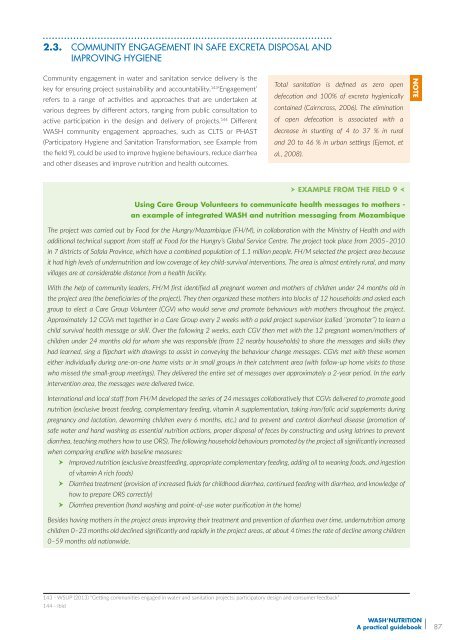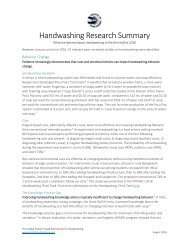WASH’ Nutrition
manuel_wash_nutrition_online
manuel_wash_nutrition_online
Create successful ePaper yourself
Turn your PDF publications into a flip-book with our unique Google optimized e-Paper software.
2.3. Community engagement in safe excreta disposal and<br />
IMPROving hygiene<br />
Community engagement in water and sanitation service delivery is the<br />
key for ensuring project sustainability and accountability. 143 ‘Engagement’<br />
refers to a range of activities and approaches that are undertaken at<br />
various degrees by different actors, ranging from public consultation to<br />
active participation in the design and delivery of projects. 144 Different<br />
WASH community engagement approaches, such as CLTS or PHAST<br />
(Participatory Hygiene and Sanitation Transformation, see Example from<br />
the field 9), could be used to improve hygiene behaviours, reduce diarrhea<br />
and other diseases and improve nutrition and health outcomes.<br />
Total sanitation is defined as zero open<br />
defecation and 100% of excreta hygienically<br />
contained (Cairncross, 2006). The elimination<br />
of open defecation is associated with a<br />
decrease in stunting of 4 to 37 % in rural<br />
and 20 to 46 % in urban settings (Ejemot, et<br />
al., 2008).<br />
NOTE<br />
EXAMPLE FROM THE FIELD 9 <br />
Using Care Group Volunteers to communicate health messages to mothers -<br />
an example of integrated WASH and nutrition messaging from Mozambique<br />
The project was carried out by Food for the Hungry/Mozambique (FH/M), in collaboration with the Ministry of Health and with<br />
additional technical support from staff at Food for the Hungry’s Global Service Centre. The project took place from 2005–2010<br />
in 7 districts of Sofala Province, which have a combined population of 1.1 million people. FH/M selected the project area because<br />
it had high levels of undernutrition and low coverage of key child-survival interventions. The area is almost entirely rural, and many<br />
villages are at considerable distance from a health facility.<br />
With the help of community leaders, FH/M first identified all pregnant women and mothers of children under 24 months old in<br />
the project area (the beneficiaries of the project). They then organized these mothers into blocks of 12 households and asked each<br />
group to elect a Care Group Volunteer (CGV) who would serve and promote behaviours with mothers throughout the project.<br />
Approximately 12 CGVs met together in a Care Group every 2 weeks with a paid project supervisor (called ‘‘promoter’’) to learn a<br />
child survival health message or skill. Over the following 2 weeks, each CGV then met with the 12 pregnant women/mothers of<br />
children under 24 months old for whom she was responsible (from 12 nearby households) to share the messages and skills they<br />
had learned, sing a flipchart with drawings to assist in conveying the behaviour change messages. CGVs met with these women<br />
either individually during one-on-one home visits or in small groups in their catchment area (with follow-up home visits to those<br />
who missed the small-group meetings). They delivered the entire set of messages over approximately a 2-year period. In the early<br />
intervention area, the messages were delivered twice.<br />
International and local staff from FH/M developed the series of 24 messages collaboratively that CGVs delivered to promote good<br />
nutrition (exclusive breast feeding, complementary feeding, vitamin A supplementation, taking iron/folic acid supplements during<br />
pregnancy and lactation, deworming children every 6 months, etc.) and to prevent and control diarrheal disease (promotion of<br />
safe water and hand washing as essential nutrition actions, proper disposal of feces by constructing and using latrines to prevent<br />
diarrhea, teaching mothers how to use ORS). The following household behaviours promoted by the project all significantly increased<br />
when comparing endline with baseline measures:<br />
Improved nutrition (exclusive breastfeeding, appropriate complementary feeding, adding oil to weaning foods, and ingestion<br />
of vitamin A rich foods)<br />
Diarrhea treatment (provision of increased fluids for childhood diarrhea, continued feeding with diarrhea, and knowledge of<br />
how to prepare ORS correctly)<br />
Diarrhea prevention (hand washing and point-of-use water purification in the home)<br />
Besides having mothers in the project areas improving their treatment and prevention of diarrhea over time, undernutrition among<br />
children 0–23 months old declined significantly and rapidly in the project areas, at about 4 times the rate of decline among children<br />
0–59 months old nationwide.<br />
143 - WSUP (2013) “Getting communities engaged in water and sanitation projects: participatory design and consumer feedback”<br />
144 - Ibid<br />
<strong>WASH’</strong><strong>Nutrition</strong><br />
A practical guidebook<br />
87



